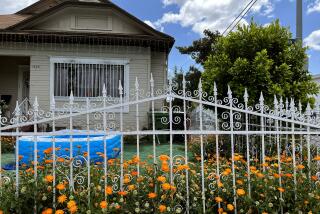Here Change Has Become a Dirty Word
- Share via
I’m for planned growth. I’m for reasonable high-rise development. I want to see new jobs in industry so that poor inner-city kids have an alternative to drug dealing. But Not In My Back Yard, ya don’t.
Ich bin ein NIMBY.
It’s easy to call NIMBYs selfish. But can you imagine anyone saying, “Sure. Go ahead and put that Center for the Criminally Insane on my block.”
When it comes to our immediate environment, we have all become conservatives--we’re all afraid of change. Could it have anything to do with the fact that almost every change in urban America in the past 30 years has made life worse?
Whether the neighborhoods have gone upscale or downscale, they haven’t gotten more livable.
I can remember cities that were wonderful places to play and live. There was a time when you could actually enjoy a “lower-middle-class life style.”
I grew up in Chicago without a car, without a back yard and without a single neighborhood gourmet or franchised food shop. You could go anywhere by bus. You could play in the park at night. You could grab a “red hot,” fries and a Coke from a place called Bow Wow for under a buck.
Crime and social chaos have erased this scene. My old apartment house burned down in a riot. The only thing that’s been built in the neighborhood since 1957 is a McDonald’s and a Church’s Chicken. But this is not the only paradise I’ve seen lost.
When I came to California in the late ‘60s, I thought I had found heaven with an average temperature of 70 degrees. We rented a two-bedroom flat for $150. We lived in a pleasant, slightly run-down neighborhood with pleasant, slightly run-down neighborhood shops around the corner. I stayed on that block for 20 years.
Two years ago, we moved. Why? Because every single change in that neighborhood--mostly upscale moves that made the property 10 times more valuable--made the neighborhood worse to live in.
It began when a drugstore became a fresh-roast coffee shop, a house became an acclaimed restaurant, a laundry became a cappuccino cafe, and the dime store became a chocolate truffle cathedral. This led to more traffic, parking problems and higher rents.
In an attempt to solve these problems, the city put in a traffic barrier on a nice residential street nearby. This shoved all the traffic onto my nice residential street.
A funeral home was converted into a mini-mall with more boutiques. Angry residents couldn’t park near their homes. They demanded and got permit-only parking. But the special parking zone stopped just short of my block, which became the parking lot for the whole community.
One neighbor talked about how she hated to go to her car in the morning as commuters circled the block like sharks, waiting for a glint of key.
The little church at the corner ceased to be a religious institution and became a money-making rental space. On weekend nights, our peace and quiet was shattered by the sounds of amplified music and the varrooming of motorcycles from the departing dancers.
One afternoon the church was filled with a group who practiced “chaotic meditation.” This consisted of five hours of jumping and screaming. After hour three, I went out to commiserate with the nice old man who lived next to the church. He was staring at the church while watering his lawn. He shouted at me above the din of the chaotic meditators, “I don’t get it--a house of worship?”
He sold his house a year later.
Two years ago, we moved to a block that is as geographically inaccessible as any in the city. I have to hike 2 miles to buy a carton of milk. When the street sign falls down, no one wants it replaced. The street itself is so filled with potholes that a truck can hardly negotiate it. But nobody calls the city. We don’t want them to know we’re here.
And if anybody tries to put in so much as one single store selling one single croissant in this neighborhood, it’ll be over my hysterical body.
More to Read
Inside the business of entertainment
The Wide Shot brings you news, analysis and insights on everything from streaming wars to production — and what it all means for the future.
You may occasionally receive promotional content from the Los Angeles Times.










